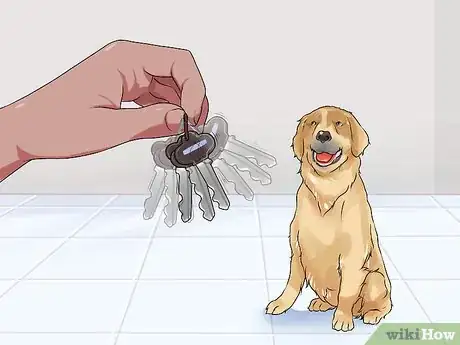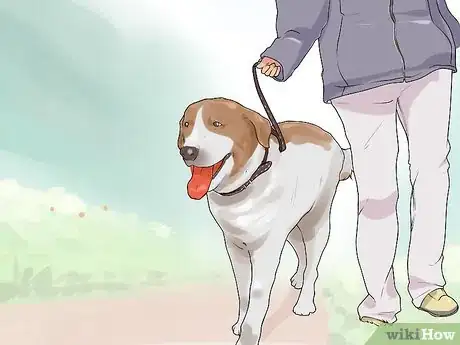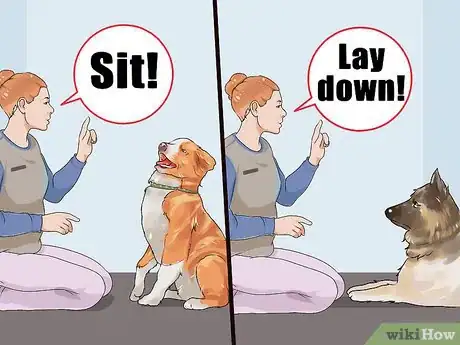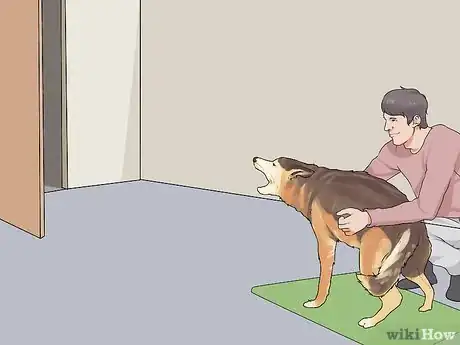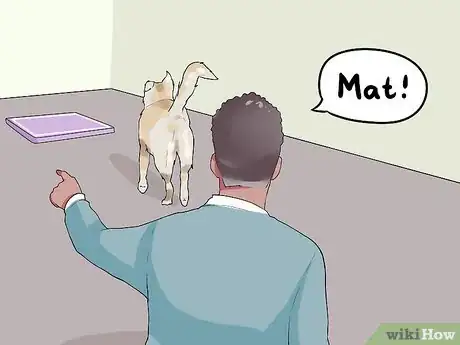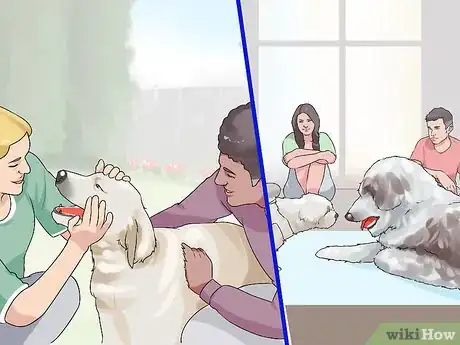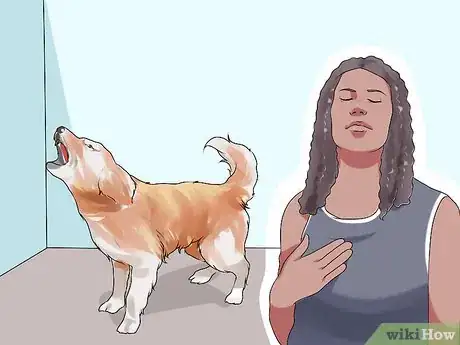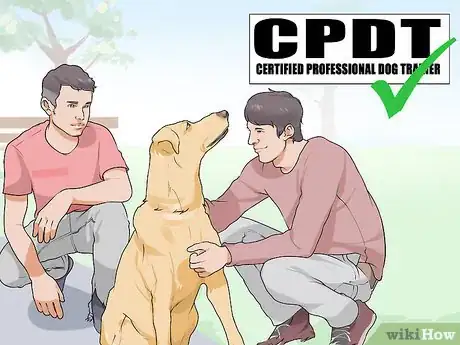This article was co-authored by Deanne Pawlisch, CVT, MA. Deanne Pawlisch is a Certified Veterinary Technician, who does corporate training for veterinary practices and has taught at the NAVTA-approved Veterinary Assistant Program at the Harper College in Illinois and in 2011 was elected to the board of the Veterinary Emergency and Critical Care Foundation. Deanne has been a Board Member of the Veterinary Emergency and Critical Care Foundation in San Antonio, Texas since 2011. She holds a BS in Anthropology from Loyola University and an MA in Anthropology from Northern Illinois University.
There are 8 references cited in this article, which can be found at the bottom of the page.
This article has been viewed 24,708 times.
If your dog constantly barks at your neighbors from the window or your yard, you can get it to stop by using command training, social training, or a combination of the two. Try ignoring your dog’s behavior or training it with a clicker or commands. Teach your dog to go to a spot in the room and sit or lay when it barks. Be patient with your dog, familiarize it with the neighbors, and don’t hesitate to consult a trainer if you run into difficulties.
Steps
Training Your Dog To Be Quiet
-
1Try ignoring the behavior first. If you haven’t tried already, ignore your dog completely when it barks. Chances are, you give it some form of attention when it starts barking at neighbors or passersby. Your dog interprets this attention as a form of reward, which reinforces the noisy behavior.[1]
- Don’t look at, touch, talk to, or otherwise give it any attention whatsoever while it barks.
- Have a small food treat handy. As soon as it stops barking, give it the treat and some verbal praise. If you reward it as soon as it becomes quiet, it will associate calming down with the reward.
-
2Do clicker training. Clicker training is a positive reinforcement training method that has proven to be very successful for training dogs and other animals. Rewarding your dog for what they do right is much more effective than punishing them for what they do wrong. By clicking the clicker right when the dog does what they’re supposed to and then giving them a treat, you can clearly communicate to the dog what they’re being rewarded for.[2]Advertisement
-
3Use a command. You can also train your dog to follow a command word such as “Quiet” or “Enough.” When it barks, say “Quiet” or “Enough” clearly and calmly, and use the same tone of voice every time you give the command.[3]
- Reward quiet behavior with pea-sized treats, and keep offering a constant stream of treats for as long as the dog remains quiet.
- Proceed with this sequence each time it barks, and keep track of its progress over the course of 10 or 20 repetitions.
-
4Make a startling noise with keys or a can of pennies. If significant time goes by and command word training isn’t successful, make a startling noise to get your dog’s attention. Shake a set of keys or rattle an empty can filled with pennies.[4]
- If you succeed at getting its attention, tell it to come, then give it a treat if it remains quiet.
- Don’t substitute the noise of metal for shouting, or the noise training won’t be effective.
-
5Give your dog more exercise. If your dog routinely barks excessively, it might have a case of canine boredom or need more exercise. Increase the length of its walks, or add another walk to its daily routine.[5]
- Most dogs require at least a combined hour of exercise per day. For example, you can combine a half hour-long brisk walk with a couple shorter walks to total an hour for that day. Larger, more active breeds, like working dogs or sporting breeds, need more. Consult your vet to put together an exercise plan that accounts for your dog's specific health and breed requirements.
- Try playing more games that offer both physical and mental stimulation, like fetch and hiding a toy or treat.
- When it barks, try distracting it with a toy, having it perform a trick, or follow some other command word such as sit or come.
Teaching Your Dog to Go to a Spot
-
1Teach your dog to sit or lay down. When you send your dog to its designated spot, you'll tell it to sit or lay down there for as long as necessary. If your dog doesn’t already know how to sit or lay down, you’ll have to first teach it one of these commands.[6]
- First, say the command calmly and clearly. Physically guide the dog into the appropriate position, then reward it with a small food treat as soon as it gets in that position. Repeat 10 to 20 times per training session to reinforce its association of following the command with a reward.
- Use pea-sized food treats when you’re just starting out, then substitute food with a toy or verbal praise.
-
2Choose a place your dog should go when it barks. Select a spot that’s still within view but at least eight feet away from the window or door. This is the spot you’ll teach your dog to go to when the doorbell rings or when it starts barking from the window.[7]
- Examples include the doorway of an adjacent room, a mat or rug at the far end of a foyer, or a stairwell with a view of the front door.
-
3Use command training to teach it to go to its spot. Choose a consistent command for your dog to follow, like “Go to your spot!” or “Mat!” Say the command, show the dog a treat, then toss the treat onto the mat or spot. Repeat this process 10 to 20 times.[8]
- After about 10 repetitions, try pretending to throw the treat to the spot. When the dog goes to the mat, toss it the treat as soon as it gets into position. Don’t give it a treat until the moment it goes to its spot.
- Make sure to use the same command with the same tone of voice every time you say it.
-
4Continue with spot training from various places. Eventually, you should say the command and your dog should go the spot on its own. When it can reliably go to its spot, start mixing up when and from where you give it the command. Try giving the command from another room, and reward the dog when it gets to its spot.[9]
-
5Add sit or lay down to the spot command. When you’re sure it understands the spot command, start telling it to stay or lay down once it’s in position.[10]
- Say “Go to your spot,” and give a pea-sized reward when it gets to its spot. Then say “Sit!” or “Lay down!” and again offer a small food treat.
- Repeat this sequence 10 to 20 times each day to reinforce the spot and sit or lay down command combination.
Making the Most of Social Training
-
1Get your dog used to new sights and smells. While command training can be an effective way to modify behavior, social training is the foundation of preventing barking problems. If you have a puppy, start introducing it to children, other animals, your neighbors, and other new sights and smells as soon as possible.[11]
- Get your dog used to your neighbor by making a good introduction. Have your neighbor give your dog a treat when it stops barking, and do so regularly if necessary. If your dog knows command words, have your neighbor tell your dog to sit and offer a treat when it follows the command.
-
2Be patient and consistent. Both command and social training take time and repetition. Make sure everyone in your household knows what specific command words your dog understands. Have everyone give command words with the same tone of voice.[12]
- Make sure no one encourages your dog to bark by saying things like, “Who’s that?!” or getting up to look out the window.[13]
- Remember to avoid yelling at your dog when it barks, unless you’re clearly and firmly saying a command word it understands. If you say “No!” or yell, your dog might think that you’re barking, too, which will reinforce the noisy behavior.[14]
-
3Consult a trainer if you need help. If your dog isn’t responding to command or social training, consider enrolling it in obedience classes or getting it a private trainer or a veterinary behaviorist. Ask your dog-owning friends and family or your dog’s vet for a referral.[15]
- Look for a board Certified Veterinary Behaviorist or a Certified Professional Dog Trainer (CPDT). When choosing a trainer, check their websites to identify their certifications. Look for reviews online, and ask trainers if they have any current clients who can offer testimonials.
- Go to http://www.dacvb.org/about/what-is-acvb/ or https://www.karenpryoracademy.com/ to find a quality trainer or behaviorist.
References
- ↑ http://www.humanesociety.org/animals/dogs/tips/how_to_stop_barking.html
- ↑ http://www.akc.org/content/dog-training/articles/what-is-clicker-training-a-great-way-to-shape-your-dogs-behavior/
- ↑ http://www.aspca.org/pet-care/dog-care/common-dog-behavior-issues/barking
- ↑ http://www.aspca.org/pet-care/dog-care/common-dog-behavior-issues/barking
- ↑ https://positively.com/contributors/how-to-train-your-dog-not-to-bark-at-the-neighbors/
- ↑ http://www.aspca.org/pet-care/dog-care/common-dog-behavior-issues/barking
- ↑ http://www.aspca.org/pet-care/dog-care/common-dog-behavior-issues/barking
- ↑ http://www.aspca.org/pet-care/dog-care/common-dog-behavior-issues/barking
- ↑ http://www.aspca.org/pet-care/dog-care/common-dog-behavior-issues/barking
- ↑ http://www.aspca.org/pet-care/dog-care/common-dog-behavior-issues/barking
- ↑ http://www.vcahospitals.com/main/pet-health-information/article/animal-health/barking-in-dogs/152
- ↑ http://www.peteducation.com/article.cfm?c=2+2085&aid=153
- ↑ http://dogtime.com/dog-health/general/675-barking-aspca
- ↑ https://positively.com/contributors/how-to-train-your-dog-not-to-bark-at-the-neighbors/
- ↑ http://www.aspca.org/pet-care/general-pet-care/behavioral-help-your-pet
About This Article
If you want to stop your new dog from barking at the neighbors, try ignoring the behavior. Your dog might interpret any attention as a reward for barking, so completely ignore it until it is quiet, then give it a small treat. You can also teach it to be quiet by using a command word like “Quiet” or “Enough” when it makes noise. Once your dog stops barking when you say the command, reward the behavior with a constant stream of pea-sized treats to ensure it stays quiet. For more advice from our Veterinary co-author, including how to socialize your dog to avoid barking, scroll down!


